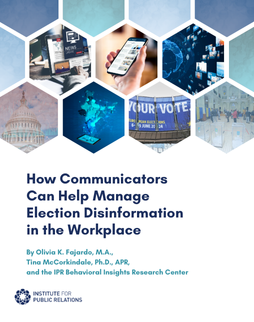This blog is provided by the IPR Organizational Communication Research Center.
When Dr. Shannon Bowen and I started conducting interviews in February of 2020 for a new study on organizational listening, we had no idea that the focus of our study would shift due to one of the biggest health crises of our lifetime. We halted data collection for our study for several months as everyone’s lives were completely disrupted. When we resumed interviews in May, the focus turned to the pandemic’s transformational impact on internal communication and organizational listening.
Macnamara (2016) recommended that organizational listening should involve seven canons of listening, including “giving recognition to others” and treating them with respect, acknowledging others’ views and perspectives in a timely manner, paying attention to others and interpreting what they have to say as fairly and openly as possible, trying to understand others’ views, perspectives, and feelings; giving appropriate consideration to what others say, and responding in an appropriate way (p. 151).
Our study was sponsored by a grant from the Arthur W. Page Center. It involved 30 in-depth interviews with communication professionals specializing in internal and external communication, followed by an online survey with approximately 250 professionals. While the study is still in progress, here are several lessons to take away based on the experiences of public relations executives.
1.) Shift from annual surveys to more frequent pulse surveys
Employers needed to receive more timely feedback from employees about the challenges they faced with remote work due to schools closing and a lack of childcare options. In addition, they needed ways to gauge a sense of employees’ health and safety concerns. While there is still a need for more thorough annual surveys on topics such as employee engagement, we will likely continue to see the use of more frequent surveys for more timely feedback.
2.) Challenge of staying connected and listening to colleagues working remotely
Several communication executives discussed how they missed being able to engage in dialogue and collaborate with colleagues sitting at desks nearby. Now they have to be more deliberate in picking up the phone or setting up a virtual meeting to stay connected and aware of what is happening in other areas of the organization.
3.) Need for empathy in organizational communication
Listening has been described as comprising at least three dimensions: cognitive, behavioral and affective (Lipetz, Kluger & Bodie, 2020). The cognitive dimension captures practices such as understanding, receiving and interpreting the message. The behavioral dimension refers to verbal and non-verbal responses, such as asking questions to clarify information and engaging with eye contact. Finally, the affective dimension encompasses emotions such as empathy and respect (Lipetz, Kluger & Bodie, 2020). These dimensions are much more difficult to fulfill when communicating remotely, but in particular, we have found that empathy is especially needed right now. Through our interviews, we found a heightened sense of empathy associated with concern for employees’ health and safety, employees who had family members affected by the pandemic, and for employees and other stakeholders who had been impacted by furloughs and jobs losses.
4.) Need for innovative ways to listen to frontline employees
Although reaching frontline employees who do not have regular access to computers and email has always been challenging, the pandemic has widened the digital communication divide, with many senior leaders working remotely. While many employers were shifting to more frequent electronic pulse surveys, they were missing the perspectives of frontline workers like nurses, housekeeping and maintenance employees. Internal communication employees need to find innovative ways to listen to these employees despite social distancing restrictions.
5.) An even greater need to close the feedback loop
While it is always important to utilize the feedback from organizational listening, it is also vital to communicate to employees that you have heard and how you are using that information. That will result in more trust and employee willingness to provide more feedback in the future.
References
Lipetz, L., Kluger, A.N., & Bodie, G.D. (2020). Listening is listening: Employees’ perception of listening as a holistic phenomenon. International Journal of Listening, 34, 71-96.
Macnamara, J. (2016b). Organizational listening: Addressing a major gap in public relations theory and practice. Journal of Public Relations Research, 28(3-4), 146-169.





